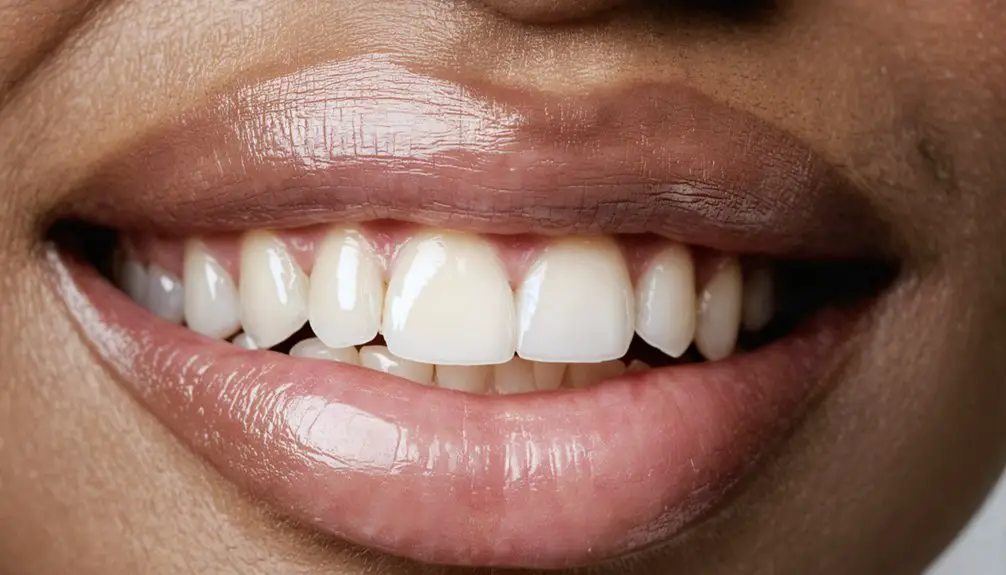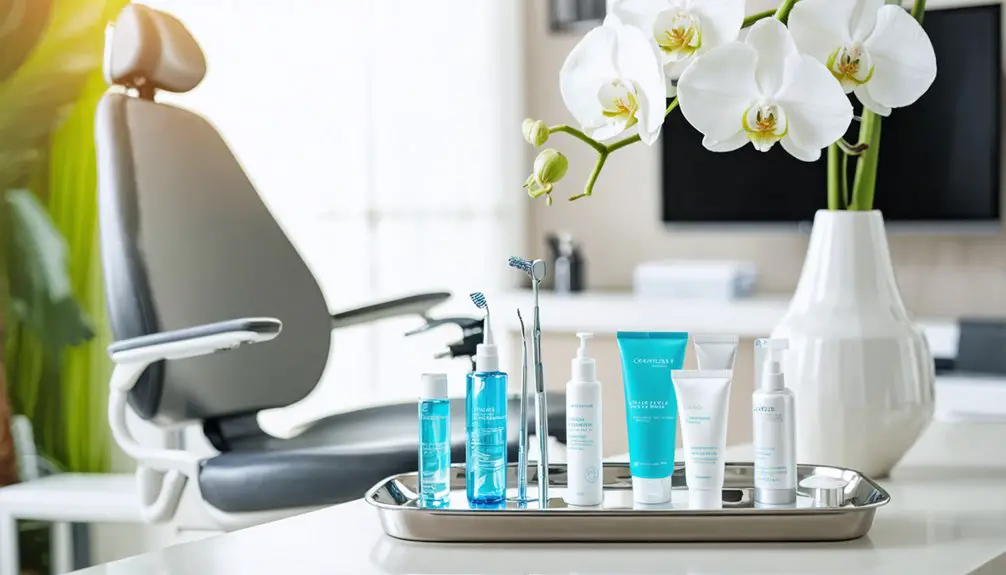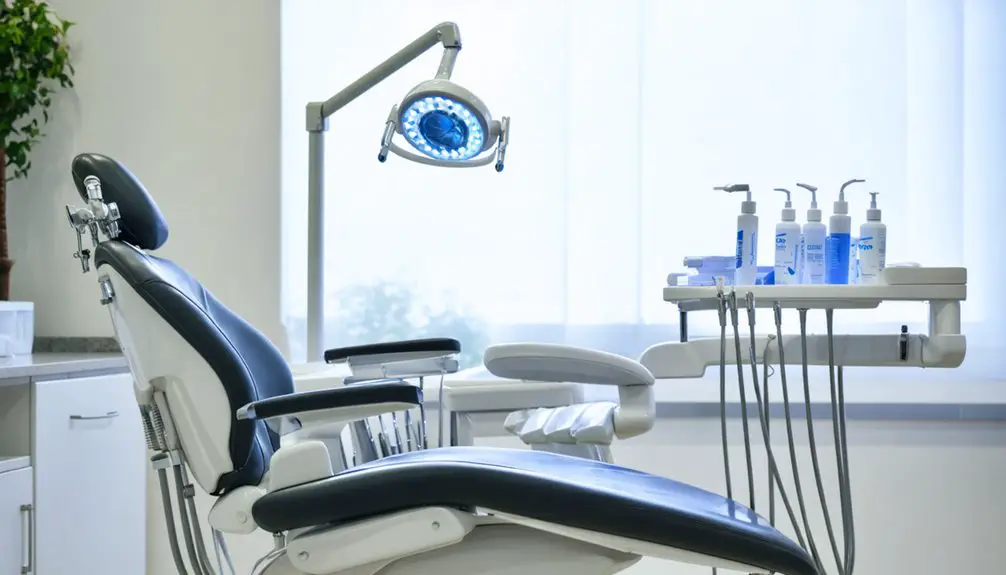Transform your smile with proven teeth whitening methods, from professional treatments to at-home solutions. You’ll find immediate results with in-office procedures like Zoom or laser whitening, which can brighten teeth up to 10 shades in one session. For gradual improvement, custom-fitted trays and commercial products with peroxide offer effective alternatives. While natural remedies exist, they’re less reliable than clinically-tested options. Understanding your options and safety considerations will guide you toward your ideal whitening journey.
Key Takeaways
- Professional whitening treatments offer the most dramatic results, brightening teeth up to 10 shades in a single 30-60 minute session.
- Custom-fitted trays with peroxide-based products provide superior coverage and gradual whitening compared to over-the-counter strips.
- Avoid natural remedies like lemon juice, which can permanently damage tooth enamel despite their appealing nature.
- Regular maintenance through proper oral hygiene and six-month professional cleanings helps preserve whitening results long-term.
- Professional treatments cost $300-$1,500 but may prove more economical due to lasting results versus repeated over-the-counter purchases.
Understanding Teeth Discoloration: Causes and Types
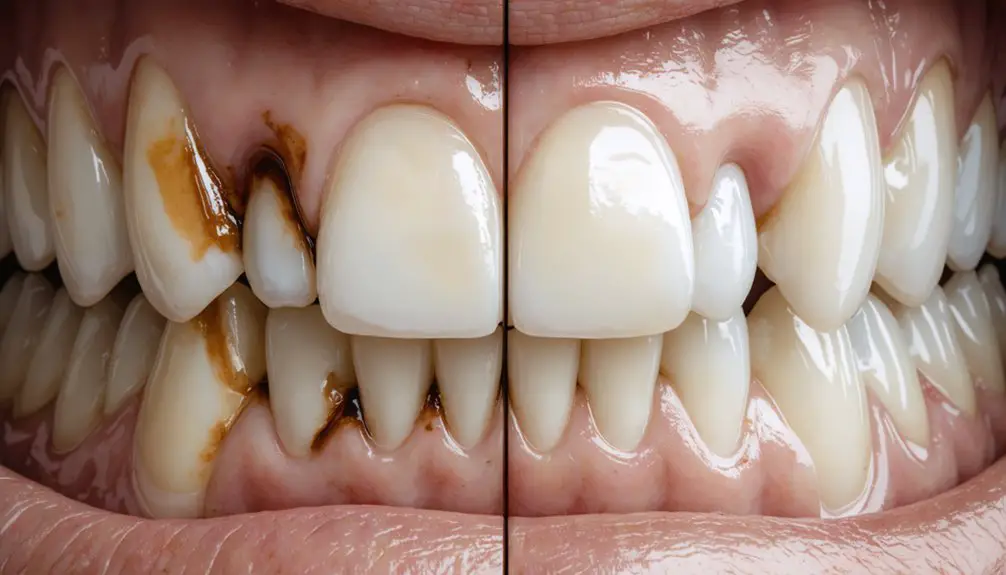
Four main categories of teeth discoloration affect dental patients: genetic and developmental causes, extrinsic surface staining, intrinsic structural changes, and medication-related discoloration.
Your genetic factors influence tooth color and enamel thickness, while developmental conditions like amelogenesis imperfecta can alter tooth formation.
Genetics shape both your natural tooth shade and enamel formation, with certain developmental disorders potentially disrupting normal tooth structure.
Extrinsic stains come from substances like coffee, wine, and tobacco, especially when poor oral hygiene allows buildup of plaque and tartar.
Intrinsic discoloration occurs when tooth structure changes internally, often due to trauma or pulpal necrosis, which affects nearly 87% of discolored teeth.
The medication impact can be significant, particularly from tetracycline antibiotics taken during tooth development.
Understanding these causes helps identify appropriate treatment approaches, whether you’re dealing with surface stains or deeper structural changes.
Professional Whitening Treatments: Options and Results
While professional in-office treatments like Zoom and laser whitening deliver immediate, dramatic results in a single session, at-home professional options using custom trays provide gradual but significant whitening over several weeks.
Laser treatments specifically offer the fastest whitening solution by using intense light to accelerate the breakdown of stains, though they’re typically the most expensive option.
You’ll find that professional whitening success largely depends on proper maintenance and lifestyle choices, with results typically lasting between 6 months to 2 years before touch-ups become necessary.
In-Office Vs Home Results
Although both in-office and at-home teeth whitening treatments can brighten your smile, professional treatments offer distinct advantages regarding speed and effectiveness.
You’ll experience more dramatic results with in-office techniques, which use higher concentrations of bleaching agents under careful supervision. A trained dental professional oversees the entire process to ensure optimal safety and results. While home treatments typically require weeks of daily application, professional whitening can transform your smile in just 60-90 minutes. Poor dental hygiene can lead to significant staining that requires professional intervention.
- Your teeth can become up to 8 shades lighter in a single professional session.
- You’ll benefit from protective barriers that shield your gums during the intense whitening process.
- Your results can last up to a year or longer with proper maintenance.
The difference in outcome justifies the higher cost of professional treatment, especially when considering that multiple home kits might be needed to achieve similar results.
Laser Treatment Benefits
Laser teeth whitening stands at the forefront of professional cosmetic dentistry, offering remarkable benefits that surpass traditional whitening methods.
When you choose laser treatment, you’ll experience dramatic results in just 30-60 minutes, with teeth brightening up to 10 shades lighter in a single session.
The laser treatment advantages extend beyond immediate results. You’ll enjoy lasting whiteness for 6-24 months, depending on your oral care routine.
The procedure’s effectiveness stems from the laser’s ability to activate specialized gels that penetrate deep into your enamel, breaking down stubborn stains at the molecular level.
Under professional supervision, you’ll receive customized treatment that’s both safe and minimally invasive, with less than 2% of patients reporting mild sensitivity.
Your dentist will guarantee ideal whitening while protecting your teeth’s natural structure.
Long-Term Whitening Success
Professional teeth whitening offers multiple paths to achieving a brighter smile, with each method delivering distinct advantages and results.
You’ll need to maintain your results through proper care and periodic touch-up treatments to guarantee long-lasting whiteness.
- Limit exposure to staining agents like coffee, tea, and red wine immediately after treatment.
- Establish a consistent oral hygiene routine with whitening toothpaste and professional cleanings.
- Schedule touch-up treatments every 6-36 months based on your whitening frequency needs.
Your results can last several years with proper maintenance.
The growing popularity of natural whitening agents provides gentler options for those seeking eco-friendly dental care solutions.
Professional supervision guarantees safe, effective treatments tailored to your needs.
Remember that whitening outcomes vary based on your initial tooth color and lifestyle habits.
Regular dental check-ups will help monitor your results and determine when additional treatments might be necessary.
At-Home Whitening Methods That Actually Work
When searching for effective at-home teeth whitening solutions, products containing hydrogen peroxide or carbamide peroxide deliver the most reliable results.
Contrary to common whitening myths, natural DIY techniques like coconut oil pulling won’t actually bleach your teeth, though they may support oral hygiene.
For ideal results, custom-fitted trays with peroxide gel offer superior coverage and effectiveness compared to strips, often showing improvement within days.
While whitening strips require up to two weeks for visible changes, they’re still more effective than toothpastes or rinses, which primarily address surface stains.
You’ll achieve the best outcomes by following manufacturer instructions carefully and avoiding simultaneous use of multiple whitening products.
Remember that consistent application over time produces gradual lightening – don’t expect dramatic overnight transformations from at-home treatments.
Natural Remedies Vs Commercial Products
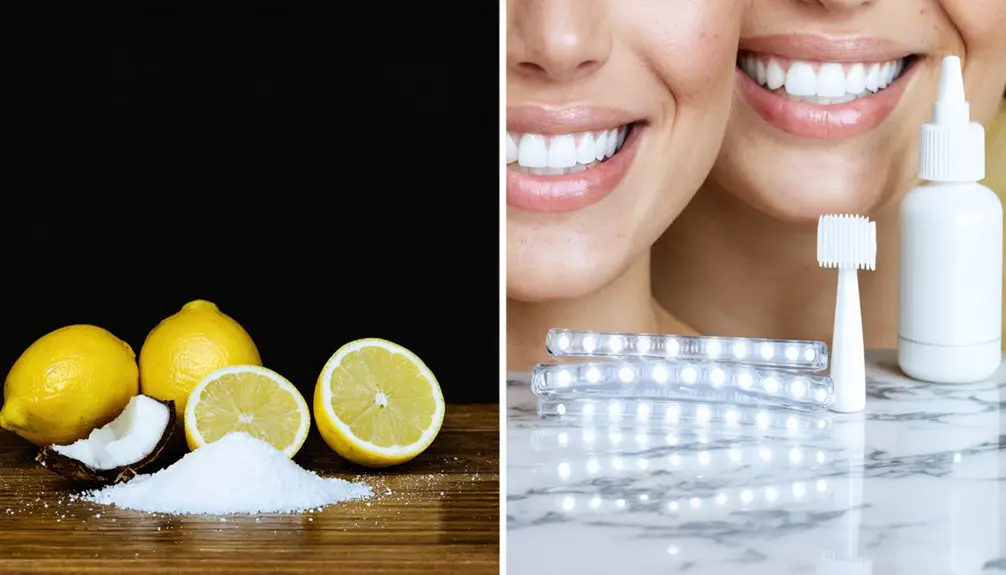
While natural teeth whitening methods like baking soda and activated charcoal offer gentler and more affordable options, they mainly address surface stains and require consistent long-term use for noticeable results.
Commercial whitening products containing peroxide-based agents provide faster, more dramatic effects and can tackle both surface and deep stains, though they’ll cost more and may cause temporary sensitivity.
You’ll need to weigh the trade-offs between natural remedies’ milder but slower results versus commercial products’ faster effectiveness and higher price point, while considering that improper use of either method can potentially damage your teeth.
Effectiveness of Natural Alternatives
Despite their growing popularity, natural teeth whitening alternatives generally prove less effective than commercial whitening products in achieving noticeable results.
When comparing natural whitening strategies to peroxide-based treatments, research shows considerably slower and less dramatic improvements in tooth color. While some natural methods like activated charcoal and strawberries do demonstrate mild whitening capabilities, they require extended use for minimal results.
- Activated charcoal provides medium abrasiveness with modest whitening effects but may roughen enamel surface.
- Strawberries offer gentle whitening through natural acids, achieving subtle improvements over time.
- Lemon juice shows the strongest natural whitening effect but damages enamel structure through acid erosion.
You’ll find that commercial products containing 10-40% peroxide consistently outperform natural alternatives in both speed and effectiveness, while maintaining better enamel safety when used as directed.
Safety Between Both Options
Safety considerations must guide your choice between natural remedies and commercial whitening products. While natural options might seem gentler, they actually carry significant risks. DIY treatments using baking soda, activated charcoal, or lemon juice can permanently erode your enamel and cause uneven whitening results.
Commercial products offer key advantages through regulated peroxide levels and standardized formulations. However, you’ll still need to follow instructions carefully to avoid sensitivity and gum irritation.
Professional supervision provides the safest approach, incorporating protective measures and desensitizing agents unavailable in home treatments.
Whether you choose natural or commercial options, be aware that overuse can lead to long-term complications. You’ll risk progressive enamel thinning, increased cavity susceptibility, and potential nerve damage without proper precautions and moderation in your whitening routine.
Cost-Benefit Comparison
When comparing natural remedies to commercial teeth whitening products, you’ll find significant variations in both cost and effectiveness that can impact your decision. A thorough cost analysis reveals that while natural remedies may seem more budget-friendly initially, they often require more time and consistent application for minimal results.
- Professional treatments ($300-$1,500) deliver immediate, dramatic results with less frequent maintenance needed.
- Over-the-counter products ($3-$60) offer moderate improvements with ongoing maintenance costs.
- Natural remedies (minimal upfront cost) require daily application with uncertain outcomes.
Your value assessment should consider long-term benefits versus initial investment. Many over-the-counter products can cause damage to enamel if used improperly.
Professional treatments, though costlier upfront, often prove more economical over time due to their lasting results and reduced need for continuous maintenance compared to DIY alternatives.
Safe Whitening Practices and Precautions
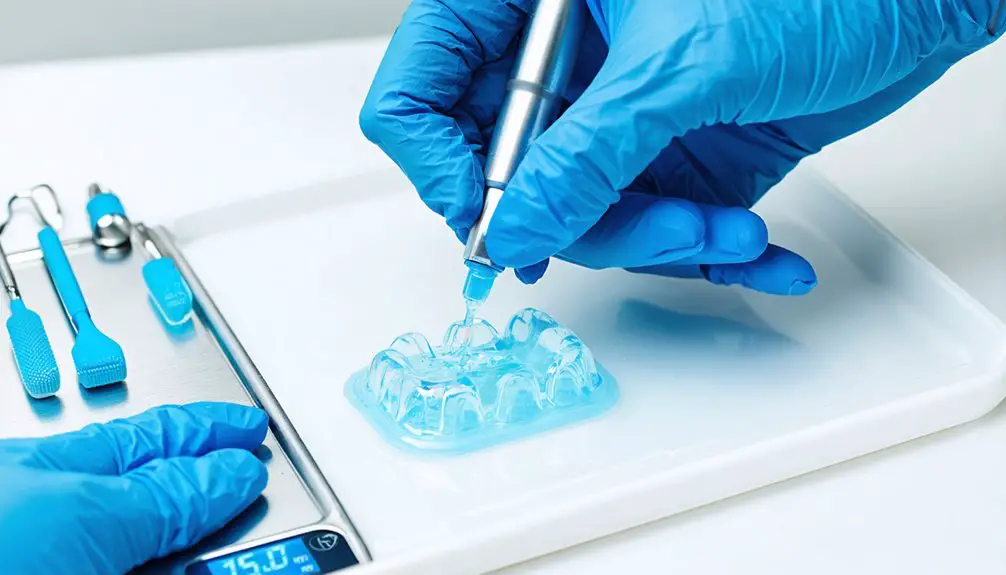
Before starting any teeth whitening regimen, consulting with a dental professional is essential to confirm both safety and effectiveness. This step is particularly important if you have existing dental issues, unfilled cavities, or gum disease.
To guarantee whitening safety, always follow product instructions strictly and never exceed recommended treatment times. If you experience sensitivity, use specialized toothpaste and consider reducing treatment frequency. For sensitivity management, take breaks between sessions to allow your enamel to recover.
Follow safety guidelines carefully and manage tooth sensitivity by using specialized products and taking breaks between whitening treatments.
Choose ADA-approved products and perform patch tests before full application. Don’t continue whitening if you notice white spots, loss of tooth shine, or persistent gum irritation.
You’ll need to avoid applying whitening products to dental work like crowns or veneers. Remember to rinse thoroughly after treatment and wait 30 minutes before eating or drinking.
Maintaining Your Bright Smile Long-Term
Maintaining your newly whitened smile requires a thorough approach that combines diligent oral hygiene, smart dietary choices, and regular professional care.
Your daily oral hygiene routine should include fluoride toothpaste, flossing, and antibacterial mouthwash to protect your investment in tooth whitening. Using a straw for beverages can significantly reduce direct contact between staining drinks and your teeth. You’ll need to adjust your dietary habits and lifestyle choices to prevent stains and preserve color retention.
- Brush twice daily with whitening toothpaste and rinse immediately after consuming staining beverages.
- Replace acidic drinks with water and incorporate crunchy fruits and vegetables for natural cleaning.
- Schedule professional cleanings every six months and follow your dentist’s maintenance routines for touch-up treatments.
Your enamel protection and stain prevention efforts will determine how long your results last, so stay committed to these practices for ideal results.
Advanced Technologies in Teeth Whitening

Recent breakthroughs in teeth whitening technology have revolutionized both professional and at-home treatments, offering patients more effective and comfortable options than ever before.
Advanced gel formulations now incorporate desensitizing agents and nano-hydroxyapatite, allowing for powerful whitening while protecting your enamel and reducing sensitivity.
You’ll find cutting-edge light activation systems using LED and laser technology that can accelerate your whitening process by up to 40%.
These treatments are precisely controlled through digital scanning and custom-fitted trays, ensuring ideal results while minimizing discomfort.
Professional-grade solutions now combine PAP-based gels with 3D-printed appliances for superior coverage and effectiveness.
With Digital Smile Design software, you can even preview your results before treatment, helping you make informed decisions about your whitening journey.
Frequently Asked Questions
Can I Whiten My Teeth While Wearing Braces or Dental Veneers?
You’ll get uneven results with braces whitening, as brackets block treatment. While veneers maintenance won’t respond to whitening, you can whiten natural teeth, but wait until braces removal for best results.
How Soon After a Root Canal Can I Start Teeth Whitening?
You’ll need to wait several weeks to a few months post root canal before starting whitening treatments. Consult your dentist for personalized timing, as proper healing guarantees whitening safety and best results.
Does Smoking Marijuana Stain Teeth Differently Than Tobacco Smoking?
Yes, marijuana effects produce lighter yellow-brown stains, while tobacco creates darker greenish-brown discoloration. Though both harm your teeth, tobacco’s staining is typically more intense and persistent than marijuana’s.
Will Teeth Whitening Affect the Color of Existing Dental Fillings?
With over 90% of adults having fillings, you’ll find that whitening options won’t change your filling color. Whitening treatments only affect natural tooth enamel, potentially creating noticeable mismatches with existing restorations.
Can Antibiotics or Medications Impact the Effectiveness of Teeth Whitening Treatments?
Yes, certain antibiotics (especially tetracycline) and medications can impact whitening effectiveness. They’ll create deep intrinsic stains that resist standard treatments and may require specialized approaches to achieve your desired results.
References
- https://www.goodhousekeeping.com/health-products/g28723133/best-at-home-teeth-whitening-products/
- https://pmc.ncbi.nlm.nih.gov/articles/PMC10024105/
- https://lanedds.com/which-teeth-whitening-technique-lasts-longest/
- https://bloommedspamn.com/how-effective-is-laser-teeth-whitening-compared-to-traditional-methods/
- https://pmc.ncbi.nlm.nih.gov/articles/PMC4058574/
- https://www.mountsinai.org/health-library/symptoms/tooth-abnormal-colors
- https://pmc.ncbi.nlm.nih.gov/articles/PMC5036264/
- https://pmc.ncbi.nlm.nih.gov/articles/PMC10133538/
- https://my.clevelandclinic.org/health/symptoms/10958-tooth-discoloration
- https://www.cdc.gov/rocky-mountain-spotted-fever/hcp/data-research/index.html
